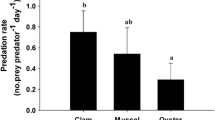Summary
Predator-prey interactions between the predatory leech, Glossiphonia complanata, and its gastropod prey were investigated in laboratory experiments, including behavioural observations with the aid of time-lapse video technique. Six gastropod species were investigated, viz. Lymnaea peregra, Planorbis planorbis, Physa fontinalis, Ancylus fluviatilis, Bithynia tentaculata, and Theodoxus fluviatilis. The species studied exhibited anti-predator defences, which had their maximum efficiency at different stages of encounter with G. complanata. The activity of B. tentaculata decreased with increasing leech activity, but was relatively higher when food was present than when not. Handling times were dependent on the time elapsed since the previous meal was captured (intercatch interval), which in turn was related to the size of the previous prey. Handling time was also related to the size of both predator and prey. The capture efficiency was high for small prey and the leeches spent more time in patches with higher yield. They were, however, unable to discriminate between patches of different prey density.
Similar content being viewed by others
References
Ansell AD (1969) Defensive adaptations to predation in the Mollusca. Proc mar biol ass India, Symp ser 3:487–512
Boag DA, Thomson C, Van Es J (1984) Vertical distribution of young pond snails (Basommatophora: Pulmonata): implications for survival. Can J Zool 62:1485–1490
Brönmark C (1985) Interactions between macrophytes, epiphytes and herbivores: an experimental approach. Oikos 45:26–30
Chernin E, Michelson H, Augustine DW (1956) Studies on the biological control of schistosome-bearing snails. II. The control of Australorbis glabratus populations by the leech, Helobdella fusca, under laboratory conditions. Am J Trop Med Hyg 5:308–314
Cook RM, Cockrell BJ (1978) Predator ingestion rate and its bearing on feeding time and the theory of optimal diets. J Anim Ecol 47:529–547
Croll RP (1983) Gastropod chemoreception. Biol Rev 58:293–319
Davies RW, Everett RP (1975) The feeding of four species of freshwater Hirudinoidea in Southern Alberta. Verh Internat Verein Limnol 19:2816–2827
Dawkins R, Krebs JR (1979) Arms races between and within species. Proc R Soc Lond B 205:489–511
Degner E (1921) Über einen Abwehrreflex bei Physa fontinalis L. Arch Molluskenkunde 53:117–120
Elliott JM, Mann KH (1979) A key to the British freshwater leeches. Freshw Biol Ass, Scient Publ No. 40
Feder HM (1972) Escape responses in marine invertebrates. Sci Am 227:92–100
Harding WA (1910) A revision of the British leeches. Parasitology 3:130–201
Janzen DH (1980) When is it coevolution? Evolution 34:611–612
Jung T (1955) Zur Kenntnis der Ernährungsbiologie der in dem Raum zwischen Harz und Heide vorkommenden Hirudinen. Zool Jahrb (Allg Zool) 66:79–128
Michelson EH (1957) Studies on the biological control of schistosome-bearing snails. Predators and parasites of fresh-water Mollusca: a review of the literature. Parasitology 47:413–426
Mittelbach GG (1981) Foraging efficiency and body size: a study of optimal diet and habitat use of bluegills. Ecology 62:1370–1386
Palmer AR (1979) Fish predation and the evolution of gastropod shell sculpture: experimental and geographic evidence. Evolution 33:697–713
Pyke GH (1984) Optimal foraging theory: a critical review. Ann Rev Ecol Syst 15:523–575
Pyke GH, Pulliam HR, Charnov EL (1977) Optimal foraging: a selective review of theory and tests. Quart Rev Biol 52:137–154
Reynoldson TB, Piearce B (1979a) Feeding on gastropods by lakedwelling Polycelis in the absence and presence of Dugesia polychroa (Turbellaria, Tricladida). Freshwat Biol 9:357–367
Reynoldson TB, Piearce B (1979b) Predation on snails by three species of triclad and its bearing on the distribution of Planaria torva in Britain. J Zool Lond 189:459–484
Sih A (1982) Optimal behavior: Can foragers balance two conflicting demands. Science 210:1041–1043
Sih A (1982) Optimal patch use: variation in selective pressure for efficient foraging. Am Nat 120:666–685
Sokal RR, Rohlf FJ (1981) Biometry. 2nd ed, Freeman, San Francisco
Sterry PR, Thomas JD, Parience RL (1983) Behavioural responses of Biomphalaria glabrata (Say) to chemical factors from aquatic macrophytes including decaying Lemna paucicostata (Hegelm ex Engelm). Freshwat Biol 13:465–476
Townsend CR (1973) The role of the osphradium in chemoreception by the snail Biomphalaria glabrata (Say). Anim Behav 21:549–556
Townsend CR, McCarthy TK (1980) On the defence strategy of Physa fontinalis (L.), a freshwate pulmonate snail. Oecologia (Berlin) 46:75–79
Underwood AJ (1979) The ecology of intertidal gastropods. Adv Mar Biol 16:111–210
Vermeij GT (1982) Unsuccessful predation and evolution. Am Nat 120:701–720
Vermeij GT, Covich AP (1978) Coevolution of freshwater gastropods and their predators. Am Nat 112:833–843
Wells MJ, Buckley SKL (1972) Snails and trails. Anim Behav 20:345–355
Wrona FJ, Davies RW, Linton L (1979) Analysis of the food niche of Glossiphonia complanata (Hirudinoidea: Glossiphoniidae). Can J Zool 57:2136–2142
Wrona FJ, Davies RW, Linton L, Willialis J (1981) Competition and coexistence between Glossiphonia complanata and Helobdella stagnalis (Glossiphoniidae: Hirudinoidea). Oecologia (Berlin) 48:133–137
Author information
Authors and Affiliations
Rights and permissions
About this article
Cite this article
Brönmark, C., Malmqvist, B. Interactions between the leech Glossiphonia complanata and its gastropod prey. Oecologia 69, 268–276 (1986). https://doi.org/10.1007/BF00377633
Received:
Issue Date:
DOI: https://doi.org/10.1007/BF00377633




